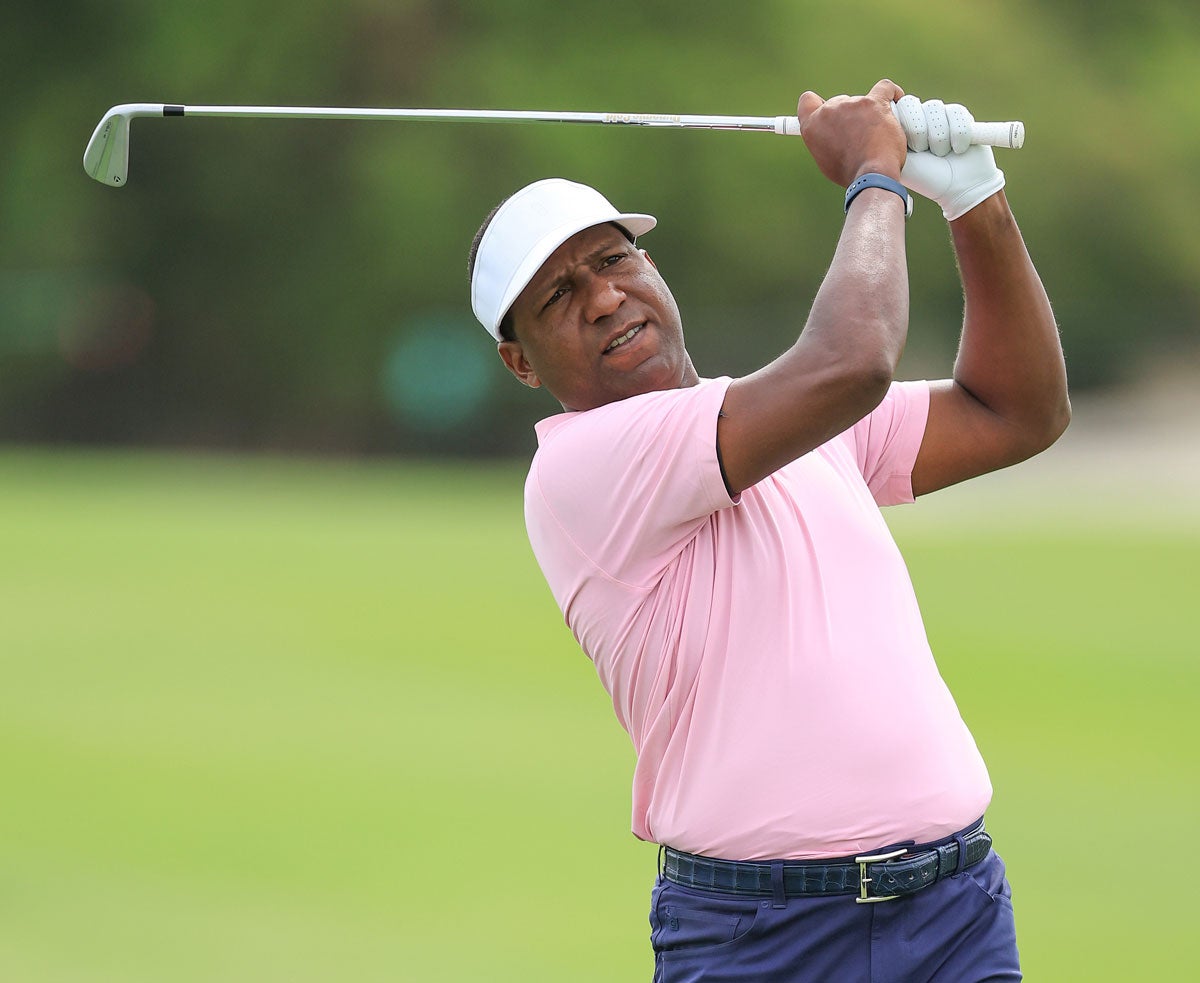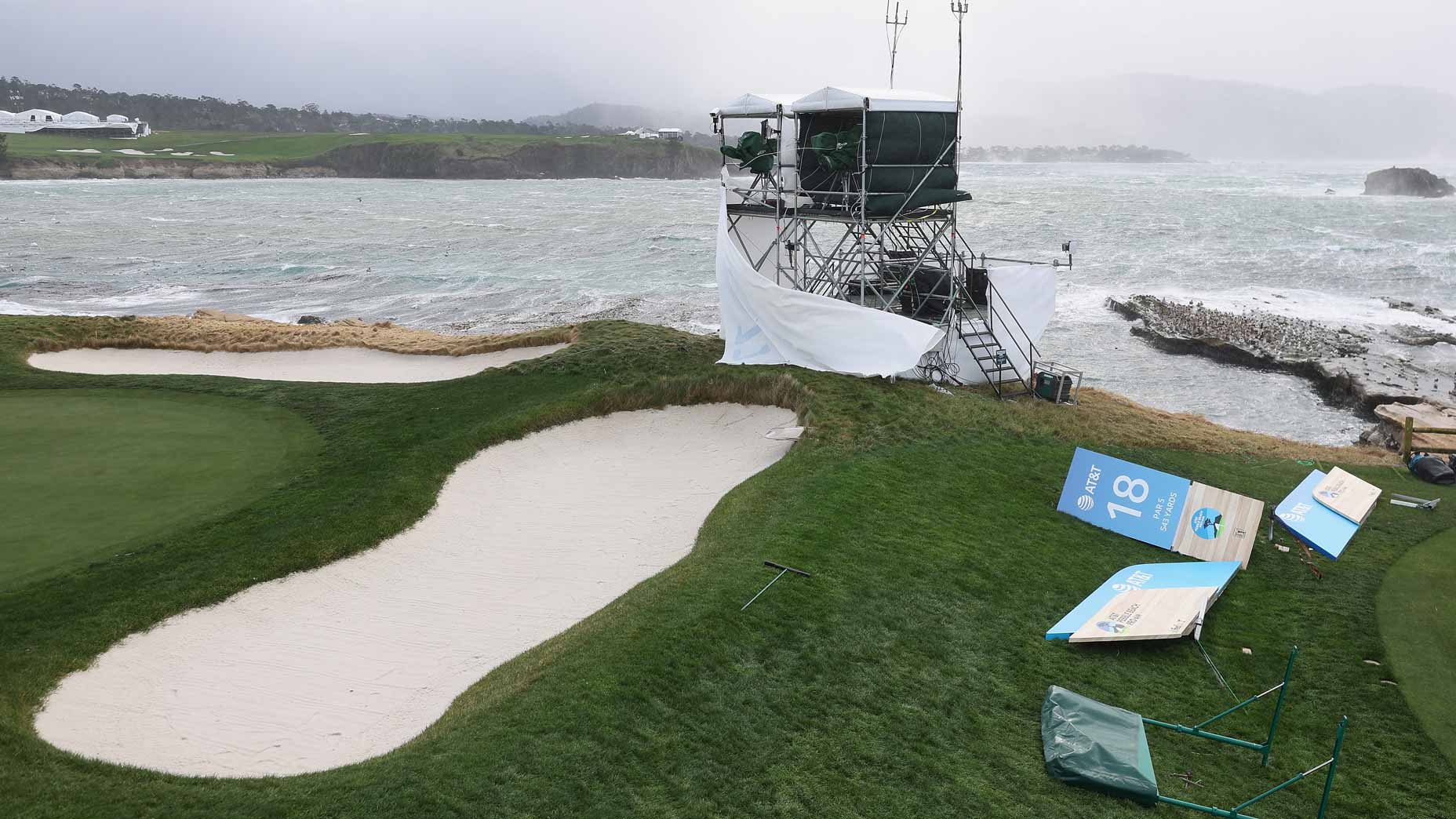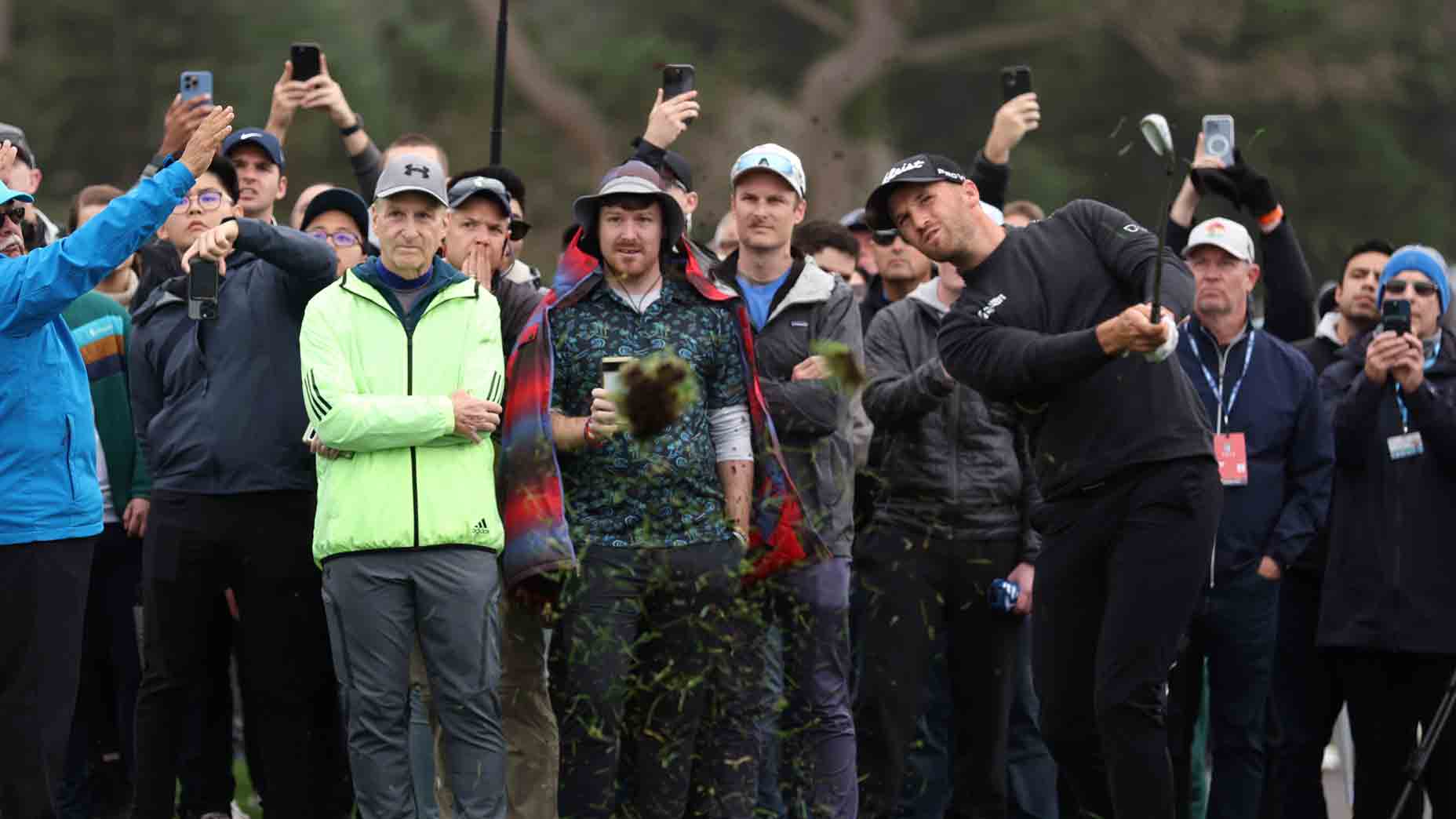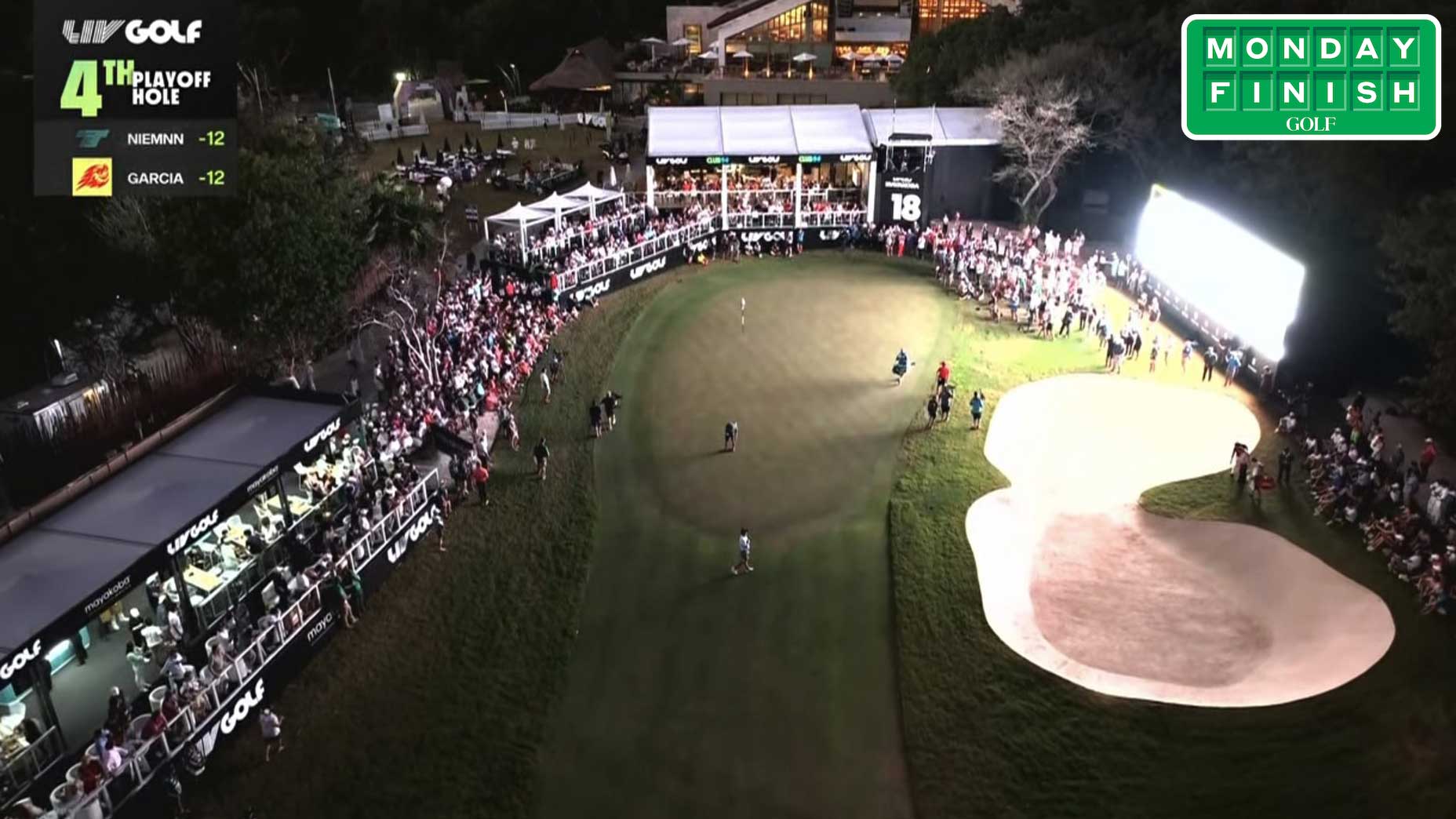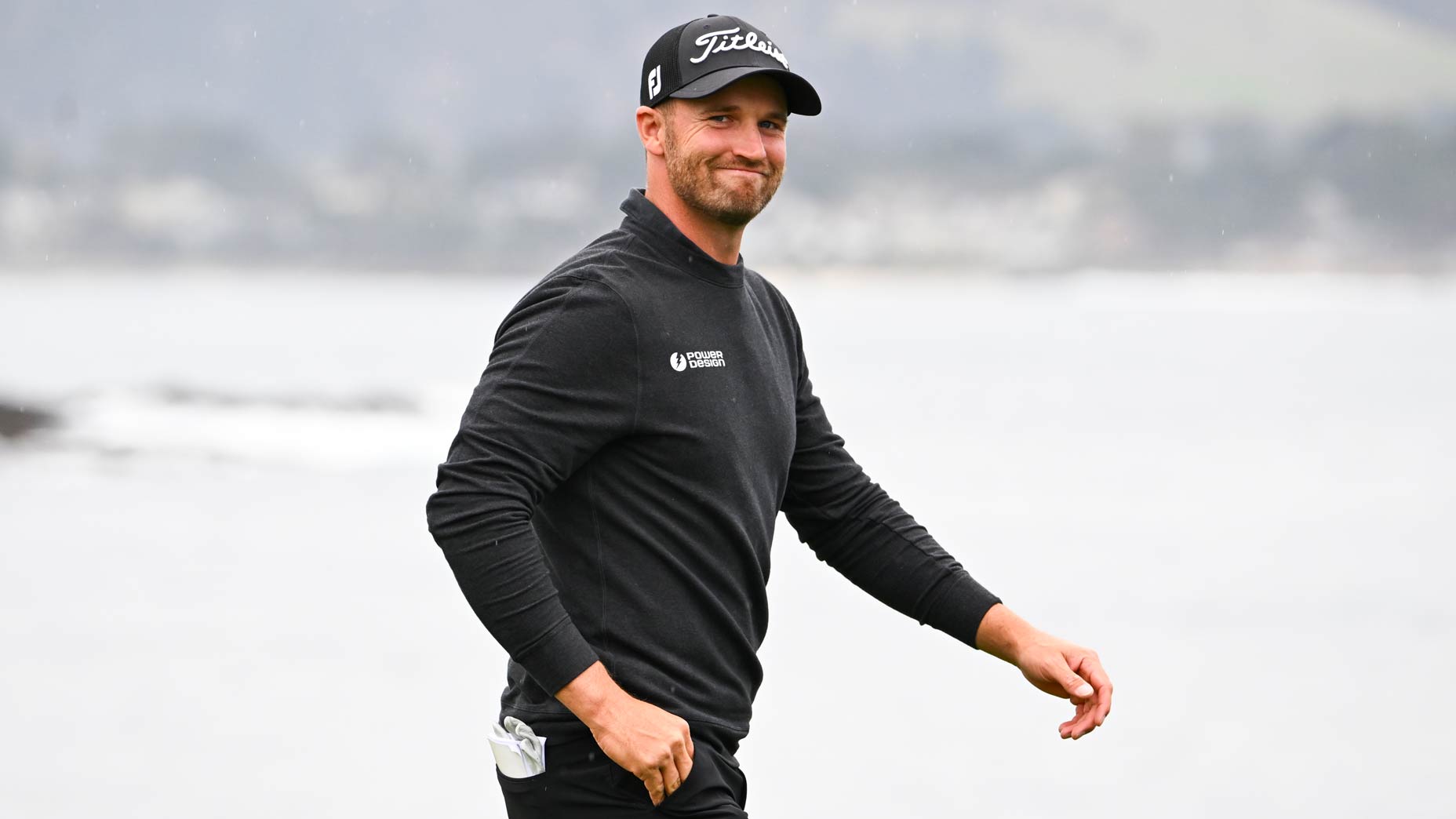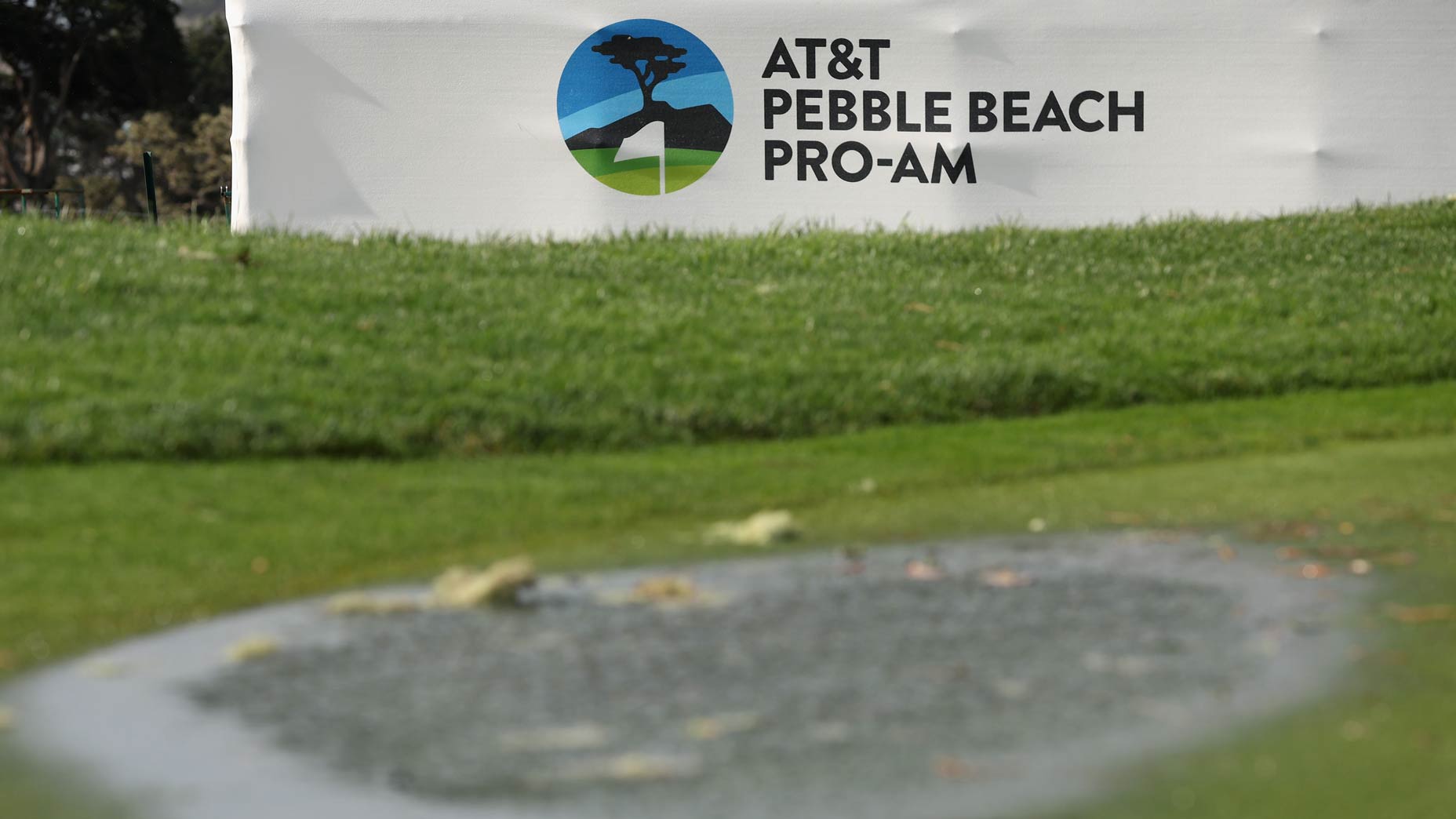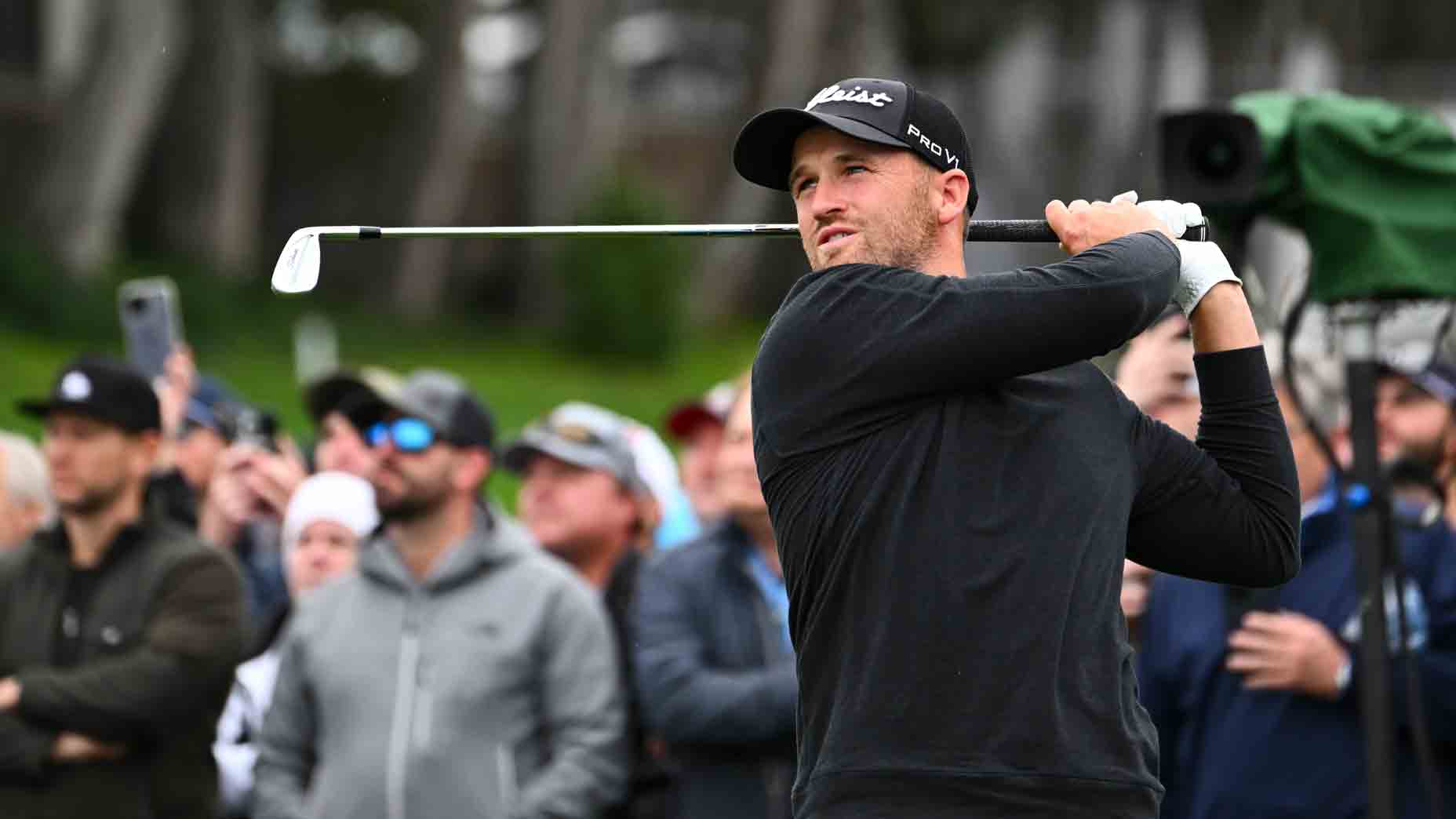What caddying at the Pebble Beach Pro-Am reveals about glue that binds the game

The author on the bag for USGA president Fred Perpall at Pebble Beach last week.
courtesy
PEBBLE BEACH, Calif. — Fred Perpall is the Fred Couples of USGA presidents. At least, on the driving range. Fred Couples hit a practice ball every 90 seconds or so in his prime as he was more interested in talking to his fraternity brothers — players, caddies, equipment reps, Tour staffers — than working on a swing that didn’t need much maintenance anyhow. Fred Perpall, the 67th president of the USGA and the first who formerly played basketball at UT Arlington, goes at it at about the same rate.
Perpall is newish to golf (he’s 49 and has been playing for about a decade) and on various ranges last week, at the Cypress Point Club (guest) and the Pebble Beach Golf Links and Spyglass Hill Golf Course (tournament courses for the AT&T), he could hardly help himself. Your textbook example of a people person.
In his Pebble travels, Fred P. had a distinctive, Bahamian how-are-you greeting posed to various Tour players, shuttle-car drivers and his fellow ams, whether they were famous football players, Wiki-certified billionaires or simply lucky-lucky-lucky, getting the invitation and all that comes with it.
Fred sees the big picture. He’s an expert on it. He starts early and goes late, working on his game (athletic 8-handicapper), pressing flesh, developing relationships. He’s an architect by training and the CEO of the Beck Group, a large design-and-construction company based in Dallas. He can read people like most of us can read a cereal box. But he’s been lucky, DNA-wise and otherwise, and he knows it. He works hard to keep this run of good luck going.
I first met Fred in 2020, at the Covid-delayed Masters, when I kept bumping into him. (He was hard to miss: 6-6, blue-blazered, bucket-hatted, loping gait.) Last week, at the AT&T, I was his caddie. In 2022, some months before he became the USGA president, he shared this intimate bit for a for a Fire Pit Collective story:
“I had a brother who was shot and killed. Two brothers from the same mother and father, who grew up in the same bedroom, who do everything in life the same way for 23 years of their life. One is running a billion-dollar company and the other is in his grave. Because of choices. Being in the wrong place at the wrong time. My brother, Randy. Went to college, just like I did. He was 25 and I was 23. I had to identify the body. That was in Dallas. I had to bring the body home to the Bahamas. My parents were heartbroken. They were never the same.”
Off-topic and disturbing, but it’s useful to remember that there’s always more going on than what we can readily see. Surface notes are surface notes, telling to a point but only to a point. Last week, when it wasn’t raining or blowing madly, you could see Fred’s old-school visor with a Seminole logo. (He joined last year.) Also, the alligator-skin headcover for his Scotty Cameron putter. (Perpall, like Matt Kuchar, briefly his Tuesday practice-round partner, is loyal to the House of Fleming in Atlanta for all his fancy-skin leather needs.) The Peter Millar duds that he wears with unshakable confidence. (Official USGA haberdasher.) But there’s more, because there’s always more, whether you’re Fred Couples, Fred Flinstone or Fred Perpall.
I was told in no uncertain terms not to lose the headcover protecting the Scotty. I didn’t. I did lose Fred’s $50 3-wood headcover for five panicky minutes at Pebble on Thursday. The other am in Fred’s foursome was Herb Allen 3d, the president of Allen & Company, the investment bank. Herb’s local caddie, Chris Musson, had picked it up. (Thank you, Chris!) Herb’s pro was a delightful Irish touring pro Seamus Power, who had a delightful Irish caddie named Simon Keelan, Fred’s pro was Lucas Glover, winner of the 2009 U.S. Open and a member of the 2001 Walker Cup team. Next year’s Walker Cup will be at Cypress Point, by the way. Expect to see a lot of good golf and a lot of Peter Millar and some of the world’s most beautiful holes. The 16th is one of the most spectacular par-3s on the planet, with a tee on one cliff, a green on another and 200 yards of ocean between them.
The committee that put Lucas G. and Fred P. together knew what it was doing. Allen & Company is an advisor to the Tour on the Tour’s deal with the Strategic Sports Group. Fred is on the board of FedEx, proud sponsors of the Tour’s FedEx Cup Playoffs. The committee, again, on its game. Nobody uses the phrase old boys’ network with a straight face anymore, but please. There were a half-dozen women playing in the pro-am this year. In 1977, Bing Crosby, in the last year of his life and in his last year as the Pebble Beach tournament host, invited two women amateurs, both college players, Marianne Bretton from UCLA and Nancy Lopez from the University of Tulsa. Fred’s wife, Abi, a dentist, was there at Pebble last week, cheering him on and seeing the sights. Their two teenaged daughters were not there. School first.
The last time I caddied was in 2005, at the Masters, and it would be a vast understatement to say that I was excited to be on the range again, wet towel in hand. So much of what’s going on in men’s professional golf now is appalling, but all that disappeared from mind as I collected a small basket of shiny TaylorMade balls for my man. To Fred’s left, on the Pebble Beach range, was Wyndham Clark, the reigning U.S. Open champion and soon-to-be Pebble Beach Pro-Am winner. I watched Fred hand Clark his trophy at the Los Angeles Country Club on Father’s Day last year. To Fred’s right was a fellow am, Dermot Desmond, an Irish businessman and uncommon gent in every way. Dermot and I share a certain devotion to the late golf sage Dewey Arnette, Dermot on an everyday and every swing basis. Golf. Golf!
Dermot’s caddie at last week’s tournament, known charmingly and for decades as the Crosby Clambake, was Bo Martin, who caddied for Shane Lowry when Lowry won the British Open at Portrush in 2019. Dewey caddied for Dermot at the AT&T, years ago. There’s a lot of that at this event, ams bringing in their golf teachers, though the preferred term now, per the PGA of America, is coaches. Why, I cannot imagine. Is there a better word than teacher
Fred had his coach with him last week, Wes Worster, a South African who teaches at Fred’s home course, Trinity Forest, a Coore-Crenshaw design in Dallas. Wes is built like Wyndham Clark and has the chin of a leading man from an old Western. Wes told me he kept fit by running after his three young children, but I think he left out his gym routine.
Wes and Fred got together when Fred made a commitment to become serious about golf, but their relationship now goes way beyond golf as they compare notes on golf and family and life. Fred shared a newly received text with us, a snippet of video featuring the Rev. T.D. Jakes, a legendary Dallas preacher, in action, quoting from a conversation Perpall had had with him: “Perpall said, ‘When my partners got better, my business got better.’” A preacherly pause. “’When my partners got better, my business got better.’” Fred would say, his life got better.
Fred Perpall is on some path here. That’s my take on him. Over the course of four days, we barely talked about the golf ball or LIV. He hit a lot of good shots. His putting stroke has a beautiful rhythm to it and his two-putt bogey on 18 on Thursday at Pebble, for a net par, improved the whole day.
His worst tee shot of the two rounds was on Friday at Spy, on the long, wet 6th, a dogleg-right par-4. With a driver in hand, Fred hit a dead pull that a crashed into a tree about 100 yards in front of the box and fell straight down. The shot was almost in a backyard where a little golf-watching party was in full swing. When Fred arrived, one of the backyarders noted that Fred’s ball was sitting in a pond of casual water. The whole course was soaked. I don’t know why but I said, “He’s a good golfer and good on the rules, too.”
I’ve caddied in the Masters and the PGA Championship, in the U.S. and British Opens and many other national championships. But until last week I had never caddied at Pebble Beach before, though I have been there often over the years, to play or cover tournaments or write other pieces. One of the first people I saw in the caddie headquarters — a ballroom located above the practice green where Tiger got his putting groove back before the 2000 U.S. Open — was Casey Boyns, a legendary Pebble Beach caddie and California amateur. Casey is loaded with soul-surfer golfing spirit. He exudes it. In this ballroom, I feel like he welcomed me back to the game I fell in love with a long time ago. Early Thursday morning I was sitting at a large catering table, marking up a yardage book, when Bones (Jim Mackay) sat down beside me and said, “Lemme see what I can learn here.” Charming! Golf should be charming, but money is a charm-killer and always has been.
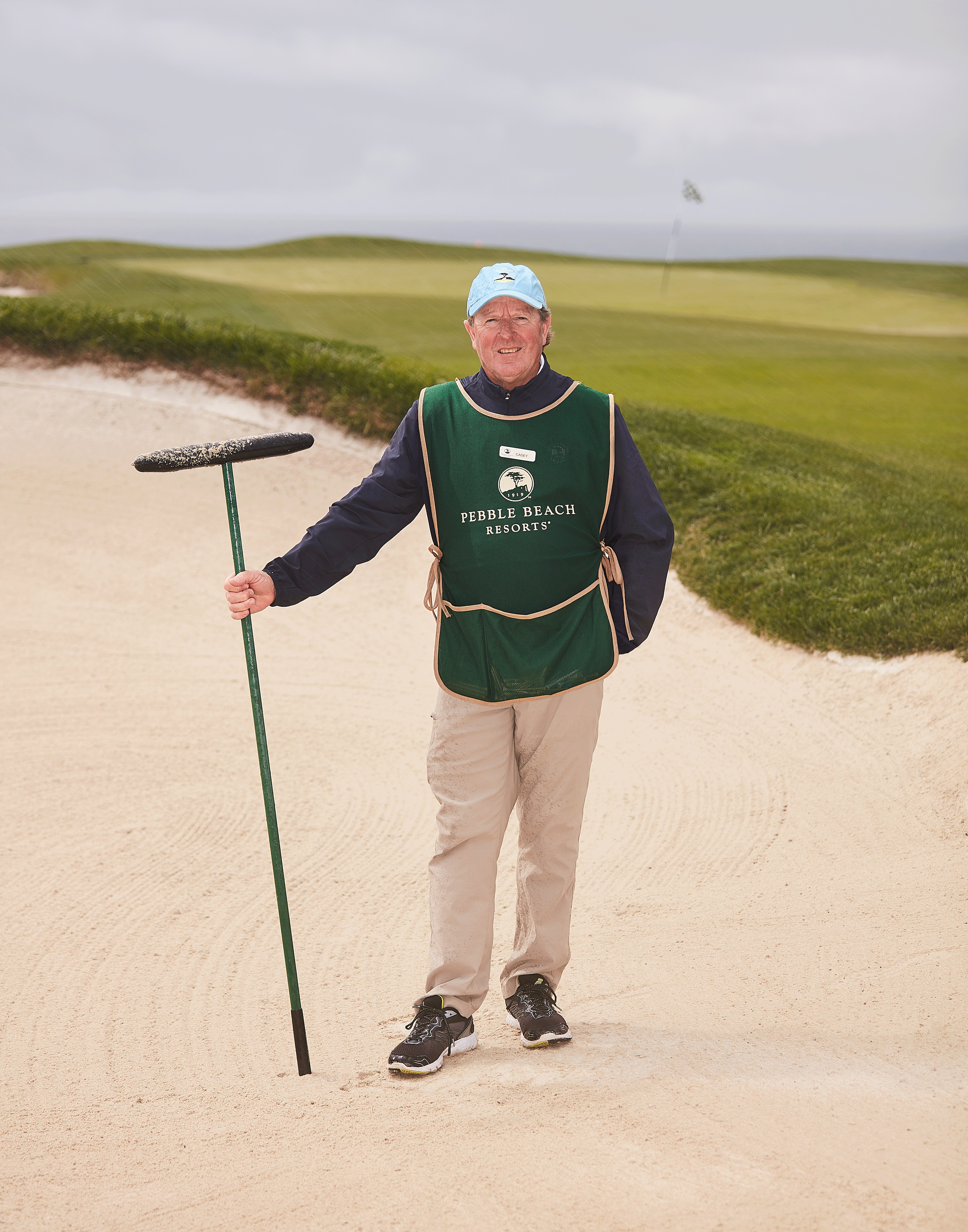
My first day on the majestic windblown ocean holes at Pebble — the flagsticks would attack you as you went to grab them — I felt like I was 25 again. (I’m 63.) But now, instead of a coupon for a hot dog and a Coke (my memory from working a long-ago Houston Open), the caddies are given a choice of outstanding hot entrees and cookies for every taste, including one with toffee bits in it. Yum.
Friday’s round at Spyglass Hill was a wet slog marked by embedded balls and long searches for balls in the rough. (But there is a certain pleasure to raking wet-sand bunkers.)
When the round was over, I couldn’t wait to get in my rental Hertz and drive over to the muni in Pacific Grove. The back nine, for a six holes or so, is as linksy as any golf anywhere. Some of my favorite rounds had come there, with Mike Donald and the late Jeff Julian (both touring pros), with Casey Boyns, with Alan Shipnuck and other writer friends, with random strangers. The green fee was $54, walking. On the back nine, I joined up with a young man named Jason Snow, 23, in college at Chico State, a caddie at Hillcrest in Los Angeles with a 10-finger grip, a good game and a dream of becoming a Pebble Beach caddie. He had come up to play golf and watch the tournament. When I asked him for a line to play to a blind green, he said, “Hit it at the rainbow.” The poetry of it was accidental.

When we got to 18, it was practically dark. The group behind us, the last group on the course, was playing with lighted balls. As Jason and I stood on the tee of the home hole, a man was sitting on a bench beside the tee. He was powerfully built with a satchel around his shoulder and a half-dozen clubs in hand. He wore a heavy, colorful woven shirt, out of a Native American tradition, with the sleeves apparently cut off. Jason asked him if he wanted to join us. The man smashed a driver off the deck without a practice swing. A completely natural, powerful swing. Truly astonishing.
We quickly introduced ourselves, in the day’s last light. We had been joined by Chris “Wags” Wagenseller, a secret Pebble Beach legend if ever there was one. He’s caddied all over the Monterey Peninsula, at Cypress and Pebble and everywhere else. Standing just off the 18th green, Jason told Wags about his dream, to caddie at Pebble, at least for a spell.
“I can hook you up,” Wags said.
“Dude, really — are you serious?”
“Yeah, man.”
Magical. Right? What a way to end the week. Saturday morning I had breakfast with a friend and started the drive to Phoenix.
I stayed last week at the home of Sam and Betsy Reeves. They are in their late 80s. When they moved to California in the early 1960s, relocating from Memphis to Fresno, they were drawn to Northern California by the promise of its burgeoning cotton industry. In their first year there, they drove to Pebble Beach to see one of the tournament courses, Cypress Point, and the players upon it. Crosby was on the course that day, just a man in a raincoat walking among other golf fans. Betsy and Sam said hello to him. That was 60 years ago.
Sam was and is an excellent golfer and he did well in the cotton business; he joined Cypress Point when he was invited to do so. He had sponsored Chris Wags when he tried to play as a pro 25 years ago. He knew about the hole-in-one Wags once made on the 289-yard par-4 9th at Cypress. He once saw Wags throw a golf ball about 175 yards from the 16th tee, over the Pacific and onto a neck of adjoining land. There’s a sculpture on the Pebble Beach grounds, called the U.S. Open Monument, that captures, beautifully, the speed and life of a live golf swing. Chris Wags was the sculptor’s model. Sam knows all about Chris Wagenseller’s interesting life and times.
The loveliness of that moment on 18 at the Pacific Grove course was eclipsed by only one thing. On the Wednesday of the tournament, Sam and Betsy went to a dinner at Cypress Point and drove home in a pouring rain. As they made it from their car to the front door, there were puddles almost everywhere. Sam took his wife’s arm, showing her a route that would avoid the puddles and saying, “This way, Bets.” It was just so lovely.
Early, early the next morning, Betsy was in the kitchen. A half-moon was fading in the dawn light, the ocean was angry and a golf tournament was about to begin. Bing’s old tournament. On the schedule it’s the AT&T but to Casey Boyns and Bones Mackay and Wags and Sam and countless others it will always be Pebble.
Michael Bamberger welcomes your comments at michael.bamberger@golf.com.

